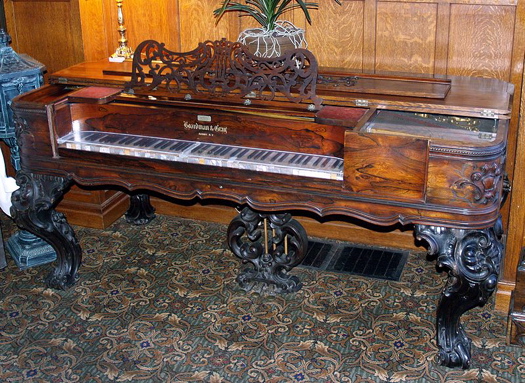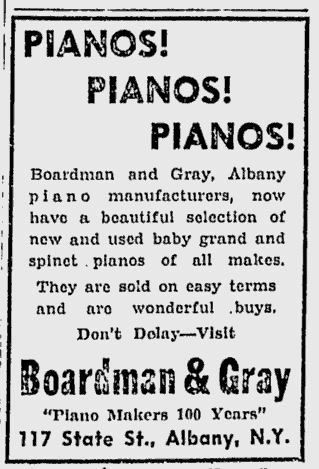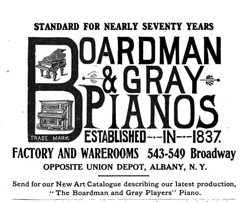The Piano City

A decorative Boardman & Gray
In the mid 1800s, as a single collar factory in Troy blossomed into dozens, Albany became famous for manufacturing a product of its own -- pianos.
In an age when people made their own music, the growing middle class felt no home was complete without a piano. So when J. & H. Meacham began manufacturing pianos around 1829, it set off a boom that could have given Albany fair claim to the nickname of "Piano City."
How it began
John and Horace Meacham started it all around 1829. Their company sold a number of instruments -- including drums and woodwinds -- at their store at 84 State Street (the space now occupied by the IBM tower). Pianos had just achieved the modern form with their full iron frame, and Horace Meacham saw a growing demand for them. Meacham convinced John Osborn, a student of the new frame's inventor, to come to Albany from Boston, and build the instruments under the J.&H. Meacham name.
The competition
I.P. Cole, a rival State Street instrument dealer and vocal teacher, would not be outdone by Meacham, so he hired Burns, Ballentine & Co. to build pianos for his shop in 1835. With the Panic of 1836, Cole's business went to one of his backers, a wholesale grocer named William G. Boardman. Apparently the piano business was more interesting or more demanding than groceries. Boardman fully immersed himself in the piano business and called on James A. Gray to partner with him. In New York City, Gray had apprenticed in piano building and distinguished himself with a number of patents for improvements to the piano, both practical and fanciful, including the "Dolce Campana" attachment, one of a number of devices designed to make a piano sound like something else -- a desire that continues in the electronic keyboard age.

Boardman and Gray
The firm became Boardman & Gray in 1837, and quickly developed a national reputation as a source of affordable, decorative pianos. In 1857, Graham's Illustrated Magazine gushed, "While on this subject, we may say--pianissimo--that Boardman, Gray & Co.'s Albany pianos have, under [piano virtuoso Sigismond] Thalberg's hands, shown themselves to be instruments of wonderful power and sweetness, rivaling the far-famed chef d'oeuvre of Erard,"Â the creator of the modern piano.
There were numerous other prominent piano-makers beside Meacham and Boardman & Gray: Grovesteen, Frickinger, Francis and Edward Burns, Henry Hazelton, William McCammon, and the firm of Marshall, James and Traver (later Marshall & Wendell) all made names for themselves as notable piano makers in Albany, nearly all of them locating somewhere along Broadway.
Most of these businesses did not outlast their founders. Only Boardman & Gray truly prospered. With a factory near the lumber district at Broadway and Dewitt streets, they opened a store at Albany's once-famous "old elm tree corner," the northwest corner of State and Pearl. (Where once grew an elm tree planted by Philip Livingston, signer of the Declaration of Independence, now grows only a Starbucks and a bank). Before the Civil War, they built one of the largest buildings in Albany, at the corner of Broadway and North Ferry, with some of the most modern equipment -- steam-powered saws, planers, lathes and polishers. By 1860 they were turning out 25 pianos a week. Despite the latest "fireproof" construction, a massive fire broke out in mid-September 1860, destroying the building, all the machines and tools, and all but 70 of the 200 pianos inside.Â

Boardman & Gray rebuilt at the same location (the "new" factory still stands, in part, on the corner of Broadway and North Ferry), but later moved to 239 North Pearl Street near Livingston. William Boardman left the firm in 1866, and James Gray, eventually made his son William a partner. In 1885, this factory also burned, taking several nearby buildings with it and killing three firemen. James Gray died just a few years later, in 1889, but William carried on and the company survived for decades more, moving the factory and showrooms to 543-549 Broadway, across from Union Station.
The fade
Piano making peaked in 1905, when 400,000 were made in the U.S. In the coming decades, radio and the phonograph changed music from something played in every family's parlor into a mostly passive form of entertainment. But Boardman & Gray, "Piano Makers 100 Years," were still building instruments at Jay and Eagle Streets and selling them just a couple of blocks away at 117 State St. as late as 1950. They were also selling electric organs, radios, and television sets. In 1957, their retail store had been taken over by Cluett & Sons, old-time piano dealers but not manufacturers, though Boardman's factory on Jay Street remained. Exactly when they went out of business isn't clear, but with them went the memory that Albany was once a hotbed of piano-making.
Photo: David Shankbone
Say Something!
We'd really like you to take part in the conversation here at All Over Albany. But we do have a few rules here. Don't worry, they're easy. The first: be kind. The second: treat everyone else with the same respect you'd like to see in return. Cool? Great, post away. Comments are moderated so it might take a little while for your comment to show up. Thanks for being patient.
Comments
Old pianos are like luggage and herpes; you can't get rid of 'em.
... said Barold on May 11, 2010 at 4:10 PM | link
Marshall & Wendell outlasted them all, though not in Albany. The American Piano Co. of Rochester bought the trademark and moved manufacturing to Rochester, though instruments continued to be marked Albany.
... said Eric Stott on May 12, 2010 at 4:18 PM | link
We have a ca. 1869 J.A. Gray square grand piano.
http://lakeportplantation.blogspot.com/2010/06/lakeports-piano-returns.html
Boardman & Gray apparently sold part of the business to William McCammon in the early 1862; In 1867 they terminated the contract with McCammon, which seemed to result in a dispute over the ownership of the name "Boardman & Gray." This seems to explain why our piano is a "James A. Gray" and not a "Boardman & Gray".
In an 1881 article in the Albany Evening Journal J.A. Gray lays claim to the Boardman & Gray name:
December 8, 1881
A Veteran Piano Manufacturer
James A. Gray & Co, at 239[?] North Pearl Street, still manufacturers the Boardman & Gray Piano. The senior partner of the firm, Mr. James A. Gray, was previous to being admitted to the firm of Boardman & Gray in 1841, foreman for Wm G. Boardman, who started the business in 1835...In 1862 the firm became embarrassed by endorsing bank paper for a firm that failed and in 1862 sold out their stock to Wm McCammon, but Mr. Gray claims that they never assigned the business. In 1867 Boardman & Gray terminated their business connection with Mr. McCammon, and was succeeded by James A. Gray & Co. on January 18, 1867. At that time the firm opened a manufactory and still continued to produce the Boardman & Gray piano at NO. 239 North Pearl Street. In 1867 the firm was composed of James A. and his brother Wm N. Gray, who remained together for ten years, when Wm . retired and Wm A. son of James A. was admitted...
While McCammon is claiming his legitimacy as the successor to "Boardman & Gray" in an 1878 article in the the Music Trade Review (April 18).
... said Blake on Jul 8, 2010 at 10:32 AM | link
I have a Meacham & Sons square piano, and it actually works quite well. Let me know if there is interest and I can send a picture.
... said Jeff Fineberg on Oct 20, 2010 at 9:43 PM | link
My brother-in-law has a Boardman & Gray of undetermined age. It was tuned at least twice with the tuner marking the inside of the case with the date of tuning. Once in 1916 and last in 1922. Can I assume the piano was manufactured just before the 1916 tuning? This pano plays very well, my niece is learning to play on it. Can you believe it, a modern-day piano tuner is refusing to attempt to tune it. My Brother-in-law is looking for a different piano tuner.
... said Smash on Dec 4, 2010 at 12:57 PM | link
I have a Boardman&Gray #75357. Wonder when it was made?
... said john fleenor on Feb 23, 2011 at 12:09 PM | link
There are a number of vintage piano forums that may be able to help, so I'd try those boards for assistance in dating your piano. Unlike some other brands, I haven't run across a definitive listing of serial numbers and dates for Boardman & Grays.
... said Carl on Feb 23, 2011 at 1:07 PM | link
Boardman & Gray made a piano with a dolce campana pedal. John Underner, an Albany musician, demonstrated it around 1850. I'm looking for descendants of John, Lewis or any of the Underner family for research in 19th century handbells. If anyone knows of Underners still living in the Albany area, please post.
... said James on Jul 8, 2013 at 10:28 PM | link
Looking for a George Gomph piano/piano forte made in Albany. Any help would be appreciated.
... said Mary on Oct 26, 2014 at 8:31 PM | link
My sister has a gorgeous Gomph square grand. It was our grandmother's high school graduation gift from her father, believe it was second-hand.
... said Karen on Dec 20, 2015 at 6:18 PM | link
Our historic home in Farmington, MO has a Boardman and Gray square grand piano in our meeting room and would love to know how to trace its history. Whether it could be tuned or not.
... said LaDonne K. Snavely on Jun 8, 2017 at 1:19 PM | link
I just bought, sight unseen, a Meachum & Co (1835) American Rosewood square piano and stool. Some keys stick and some won't strike to produce sound. Any value to this instrument?
... said Phil Guthe on Feb 15, 2018 at 4:14 PM | link